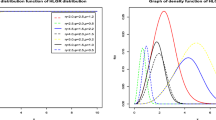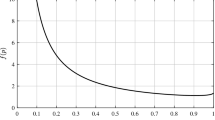Abstract
The traditional approach to modelling for Competing Risks, via a multivariate distribution of latent failure times, is very natural for many applications but suffers from a well-documented problem of identifiability. However, the demonstrations of this problem in the literature apply to essentially continuous latent failure times where any atoms of probability in their distributions are not too intrusive. It is shown in this paper that for discrete failure times the classic results on the identifiability problem concerning the existence of equivalent independent risks are incomplete.
Similar content being viewed by others
References
J. I. Ansell and M. J. Phillips, “Practical problems in the statistical analysis of reliability data (with discussion),” Appl. Statist. vol. 38 pp. 205–247, 1989.
B. Arnold and P. Brockett, “Identifiability for dependent multiple decrement/competing risk models,” Scand. Actuar. J. vol. 10 pp. 117–127, 1983.
C. L. Atwood, “The binomial failure rate common cause model,” Technometrics vol. 28 pp. 139–148, 1986.
R. A. Boyles and F. J. Samaniego, “Maximum likelihood estimation for a discrete multivariate shock model,” J. Amer. Statist. Assoc. vol. 78 pp. 445–448, 1983.
V. P. Brand, “The unified partial method: pragmatism and expert assistance in dependent failure analysis,” European Safety and Reliability Conference—ESREL 95, Bournemouth, 1995.
D. R. Cox, “The analysis of exponentially distributed lifetimes with two types of failure,” J. Roy. Statist. Soc. vol. B21 pp. 411–421, 1959.
D. R. Cox, “Regression models and life tables (with discussion),” J. Roy. Statist. Soc. vol. B34 pp. 187–220, 1972.
M. J. Crowder, “On the identifiability crisis in competing risks analysis,” Scand. J. Statist. vol. 18 pp. 223–233, 1991.
M. J. Crowder, “Competing Risks and Reliability,” Royal Statistical Society Meeting, Imperial College, London, 1991.
M. J. Crowder, “Identifiability crises in Competing Risks,” Int. Statist. Rev. vol. 62 pp. 379–391, 1994.
H. A. David and M. L. Moeschberger, The Theory of Competing Risks, Griffin: London, 1978.
T. P. Davis and A. J. Lawrance “The likelihood function for competing risk survival analysis,” Scand. J. Statist. vol. 16 pp. 23–28, 1989.
K. N. Flemming, “A reliability model for common mode failures in redundant safety systems,” General Atomic Report GA-13284, London, UK Atomic Energy Authority, 1974.
K. N. Flemming, A. Mosleh and A. P.Jr., “On the analysis of dependent failures in risk assessment and reliability evaluation,” Nuclear Safety vol. 24 pp. 637–657, 1983.
J. E. Freund, “A bivariate extension of the exponential distribution,” J. Amer. Statist. Assoc. vol. 56 pp. 971–977, 1961.
M. Gail, “A review and critique of some models used in competing risks analysis,” Biometrics, vol. 31 pp. 209–222, 1975.
C. N. Guey and C. D. Heising, “A method for estimating common cause failure probability and model parameters: the inverse stress strength interference (ISSI) technique,” in ANS/ENS International Topical Meeting on Probabilistic Safety Methods and Applications, Palo Alto, CA: Electric Power Research Institute, 1985, pp. 182–1–182–13.
J. J. Heckman and B. E. Honore, “The identifiability of the competing risks model,” Biometrika vol. 76 pp. 325–330, 1989.
J. D. Kalbfleisch and R. J. McKay, “On constant-sum models for censored survival data,” Biometrika vol. 66 pp. 87–90, 1979.
N. Langberg, F. Proschan and A. J. Quinzi, “Converting dependent models into independent ones, preserving essential features,” Ann. Prob. vol. 6 pp. 174–181, 1978.
A. W. Marshall and I. Olkin, “A multivariate exponential distribution,” J. Amer. Statist. Assoc. vol. 62 pp. 30–44, 1967.
H. F. Martz, L. R. Abramson, G. L. Tietjen and P. H. Kvam, “On monitoring nuclear power plant emergency diesel generator reliability,” American Statistical Association 1993 Proceedings of the Section of Physical Sciences and Engineering, 1993.
D. R. Miller, “A note on independence of multivariate lifetimes in competing risk models,” Ann. Statist. vol. 5 pp. 576–579, 1977.
A. Mosleh (ed.) “Special Issue on Dependent Failure Analysis,” Reliability Engineering and System Safety vol. 34 no. 3 1991.
W. B. Nelson, “Hazard plotting methods for analysis of life data with different failure modes,” J. Qual. Technol. vol. 2 pp. 126–149, 1970.
A. V. Peterson, “Bounds for a joint distribution function with fixed subdistribution functions: applications to competing risks,” Proc. Nat. Acad. Sci. USA vol. 73 pp. 11–13, 1976.
A. V. Peterson, “Expressing the Kaplan-Meier estimator as a function of empirical subsurvival functions,” J. Amer. Statist. Assoc. vol. 72 pp. 854–858, 1977.
R. L. Prentice, J. D. Kalbfleisch, A. V. Peterson, N. Flournoy, V. T. Farewell and N. E. Breslow, “The analysis of failure times in the presence of competing risks,” Biometrics vol. 34 pp. 541–554, 1978.
M. Shaked, “A general theory of some positive dependence notions,” J. Multiv. Anal. vol. 12 pp. 199–218, 1982.
A. Tsiatis, “A nonidentifiability aspect of the problem of competing risks,” Proc. Nat. Acad. Sci. USA vol. 72 pp. 20–22, 1975.
W. E. Vesely, “Estimating common cause failure probabilities in reliability and risk analysis: Marshall-Olkin specializations,” in Nuclear Systems Reliability Engineering and Risk Assessment, J.B. Fussell and G.R. Burdick, (eds.) Philadelphia: Society for Industrial and Applied Mathematics, pp. 314–341.
J. S. Williams and S. W. Lagakos, “Models for censored survival analysis: constant-sum and variable-sum models,” Biometrika vol. 64 pp. 215–224, 1977.
Author information
Authors and Affiliations
Rights and permissions
About this article
Cite this article
Crowder, M. On assessing independence of Competing Risks when failure times are discrete. Lifetime Data Anal 2, 195–209 (1996). https://doi.org/10.1007/BF00128575
Received:
Accepted:
Issue Date:
DOI: https://doi.org/10.1007/BF00128575




